Impact on Protective Device Sequence of Operation in Case Distributed Generation Integrated to Distribution System
Abstract
:1. Introduction
- To improve the protection system by minimising the serious effect of fuse-link failures during high fault conditions and managing the protection coordinate scheme between recloser setting and fuse-link sizing verifications;
- To develop the conventional protection system to increase the stability and reliability on the distribution system both with and without DG;
- To determine and apply the correct sizing of fuse-link devices at the right positions to protect the interrupting power supply to the load connections along the primary line.
2. Distribution System Simulation
2.1. Effect on Voltage Level in Case of Distribution System with DG Placements
2.2. Effect on Power Loss in Case of Distribution System with DG Placements
3. Protective Device Functional Operation in Case without DG
3.1. Protective Relay Operation Sequential at Both Recloser R1 Location and Drop-Out Fuse Device at the Position 25k Such as F2, F3, F4, and F5, Respectively
3.2. Sequential of Protective Relay Coordination between the Recloser R1 and Drop-Out Fuse Rated 15k at F1 Position
3.3. Protective Coordination between Recloser R1 and R2 Devices
3.4. Coordination with Recloser R2 and R3
3.5. Correlation between Recloser R3 and 25k Rated of Fuse-Link Device
4. Protective Device Functional Operation in Case with DG
4.1. Effect of Coordinates Are Compared with the Recloser R1 and Drop-Out Fuse of 25k Type in F2, F3, F4, and F5 Positions with DG Integrating
4.2. Effect of Protective Devices in Operating between Reclosers R2 and R3 with the Fault Location Occurs after the Recloser R2
4.3. Protective Devices Improvement When the DG Connection to the Distribution System
4.3.1. Improvement of Malfunctions between the Recloser and Fuse-Link Devices
4.3.2. Simulation in Case of AVR Relocation
5. Conclusions
Author Contributions
Funding
Institutional Review Board Statement
Informed Consent Statement
Data Availability Statement
Acknowledgments
Conflicts of Interest
References
- Razavi, S.E.; Rahimi, E.; Javadi, M.S.; Nezhad, A.E.; Lotfi, M.; Shafie-khah, M.; Catalão, J.P. Impact of Distributed Generation of Protection and Voltage Regulation of Distribution systems: A review. Renew. Sustain. Energy Rev. 2019, 105, 157–167. [Google Scholar] [CrossRef]
- Sunday, A.S.; Gafari, A.A.; Isaiah, G.A.; Oludamilare, B.A. Comparative assessment of techno-economic and environmental benefits in optimal allocation of distributed generators in distribution networks. Sci. Afr. 2023, 19, e01546. [Google Scholar]
- Muhammad, Y.; Amin, J.; Kashem, M.M.; Danny, S. An Adaptive Overcurrent Protection Scheme for Dual-Setting Directional Recloser and Fuse Coordination in Unbalanced Distribution Networks with Distributed Generation. IEEE Trans. Ind. Appl. 2022, 58, 1831–1842. [Google Scholar]
- Meskin, M.; Domijan, A.; Grinberg, I. Impact of distributed generation on the protection system of distributed networks analysis and remedies—Review paper. IET Gener. Transm. Distrib. 2020, 14, 5944–5960. [Google Scholar] [CrossRef]
- Issarachai, N.; Wikorn, K.; Suntiti, Y.; Atthapol, N. Characteristic Evaluation of Wind Power Distributed Generation Sizing in Distribution System. Sustainability 2023, 15, 5581. [Google Scholar]
- Chiradeja, P.; Yoomak, S.; Ngaopitakkul, A. Optimal Allocation of Multi-DG on Distribution System Reliability and Power Losses Using Differential Evolution Algorithm. Energy Procedia 2017, 141, 512–516. [Google Scholar] [CrossRef]
- Aly, M.M.; Mahrous, H.; Mahmoud, M.M. Recloser-fuse Coordination of Radial Distribution Systems with Different Technologies of Distributed ITCE. In Proceedings of the International Conference on Innovative Trends in Computer Engineering (ITCE), Aswan, Egypt, 2–4 February 2019; pp. 420–426. [Google Scholar]
- Yogesh, M.M.; Bhavesh, R.B.; Ramakrishna, G. Improvement in Recloser–Fuse Coordination Technique Based on Modification Factor. IEEE Syst. J. 2020, 14, 2770–2779. [Google Scholar]
- Ekramul, H.; Asfaqur, R.; Sabbir, A.; Md, R.B.; Fardin, H.; Kazi, M.M. An Adaptive Over Current Protection Scheme and Impact of Distributed Gerneration On IEEE 34 Radial Test Feeder. In Proceedings of the International Conference on Automation, Control and Mechatronics for Industry 4.0 (ACMI), Rajshahi, Bangladesh, 8–9 July 2021; pp. 1–6. [Google Scholar]
- Valbuena, G.J.; Pavas, A. Assessment of DG Effect on a Protection Scheme considering High Impedance Faults. In Proceedings of the IEEE Workshop on Power Electronics and Power Quality Applications (PEPQA), Manizales, Colombia, 30–31 May 2019; pp. 1–6. [Google Scholar]
- Asma, M.; Nesrine, S.; Hajer, J.; Souad, C. Impact of Distributed Generation on the Protection System in Tunisian Distribution Network. In Proceedings of the 15th International Multi-Conference on Systems, Signals & Devices (SSD), Yasmine Hammamet, Tunisia, 19–22 March 2018; pp. 514–520. [Google Scholar]
- Valbuena, J.; Pavas, A. Loss of Coordination in a Protection Scheme due to DG assessed by means of Reliability Analysis. In Proceedings of the IEEE Milan PowerTech, Milan, Italy, 23–27 June 2019; pp. 1–6. [Google Scholar]
- Jamal, W.; Saad, M.S.; Naser, E.N.; Khalil, E.; Faisal, A.M. Applicability Analysis of Proactive Recloser-Fuse Scheme for Wind Distributed Generation into Modern Distribution Network. In Proceedings of the 9th International Renewable Energy Congress (IREC), Hammamet, Tunisia, 20–22 March 2018; pp. 1–6. [Google Scholar]
- Chiradeja, P.; Ngaopitakkul, A. The impact of capacity and location of multidistributed generator integrated in the distribution system on electrical line losses, reliability, and interruption cost. Environ. Prog. Sustain. Energy 2015, 34, 1763–1773. [Google Scholar] [CrossRef]
- Eid, A.G.; Adel, A.; Akram, E. Sustained Coordination of Devices in a Two-Layer Protection Scheme for DGs-Integrated Distribution Network Considering System Dynamics. IEEE Access 2021, 9, 111865–111878. [Google Scholar]
- Panida, T.; Peerapol, J. Implementation of Optimal Protection Coordination for Microgrids with Distributed Generations Using Quaternary Protection Scheme. J. Electr. Comput. Eng. 2020, 2020, 2568652. [Google Scholar]
- Zilin, L.; Jiefeng, H.; Ka, W.C. A New Current Limiting and Overload Protection Scheme for Distributed Inverters in Microgrids Under Grid Faults. IEEE Trans. Ind. Appl. 2021, 57, 6362–6374. [Google Scholar]
- Nikolaidis, V.C.; Desiniotis, D.; Papaspiliotopoulos, V.A.; Tsimtsios, A.M.; Korres, G.N. Optimal Recloser-Fuse and Distribution Network Protection Coordination including Distributed Generation Relays. In Proceedings of the International Conference on Smart Energy Systems and Technologies (SEST), Eindhoven, The Netherlands, 5–7 September 2022; pp. 1–6. [Google Scholar]
- Penido DR, R.; de Araujo, L.R.; Rodrigues, V.T.; do Nascimento, K.B. An Analytical Zero Sequence Method to Locate Fault in Distribution Systems Rich in DG. IEEE Trans. Smart Grid 2022, 13, 1849–1859. [Google Scholar] [CrossRef]
- Hitesh, A.; Rai, J.N. Protection Coordination of Distributed system with Distributed Generation. In Proceedings of the International Conference on Intelligent Controller and Computing for Smart Power (ICICCSP), Hyderabad, India, 21–23 July 2022; pp. 1–6. [Google Scholar]
- Sahebkar, J.F.; Zareein, M.; Soroushmehr, H.; Mortazavi, H. Coordination of Directional Overcurrent Protection Relay for Distribution Network with Embedded DG. In Proceedings of the 5th Conference on Knowledge Based Engineering and Innovation (KBEI), Tehran, Iran, 28 February–1 March 2019; pp. 1–6. [Google Scholar]
- Mahdi, G.; Reza, M.C.; Hatem, H.Z.; Seyed, M.H.M. Design of Setting Group-Based Overcurrent Protection Scheme for Active Distribution Networks Using MILP. IEEE Trans. Smart Grid 2021, 12, 1185–1193. [Google Scholar]
- Alaa, H.E.; Ahmed, A.M.E.; Ashraf, I.M. Improved Adaptive Protection Scheme Based Combined Centralized/Decentralized Communications for Power Systems Equipped with Distributed Generation. IEEE Access 2022, 10, 97061–97074. [Google Scholar]
- Ehsan, A.; Bahador, F.; Iman, S.; Hassan, H.A. Multi-Agent System-Based Hierarchical Protection Scheme for Distribution Networks with High Penetration of Electronically-Coupled DGs. IEEE Access 2021, 9, 102998–103018. [Google Scholar]
- Mahamad, N.A. Adaptive Protection Coordination Scheme Using Numerical Directional Overcurrent Relays. IEEE Trans. Ind. Inform. 2019, 15, 64–73. [Google Scholar]
- Sadeghi, S.M.; Daryalal, M.; Abasi, M. Two-stage planning of synchronous distributed generations in distribution network considering protection coordination index and optimal operation situation. IET Renew. Power Gener. 2022, 16, 2338–2356. [Google Scholar] [CrossRef]
- Lim, S.-H.; Park, M.-K. Analysis on Protection Coordination of OCRs Using Voltage Components for the Application of SFCL in a Power Distribution System with DG. IEEE Trans. Appl. Supercond. 2021, 31, 5602106. [Google Scholar] [CrossRef]
- Muhammad, U.; Mahmoud, M.; Hazlie, M.; Nurulafiqah, N.M.; Haroon, F.; Alireza, P. Optimal Protection Coordination Scheme for Radial Distribution Network Considering ON/OFF-Grid. IEEE Access 2021, 9, 34921–34937. [Google Scholar]
- Biller, M.; Jaeger, J. Protection Algorithms for Closed-Ring Grids with Distributed Generation. IEEE Trans. Power Deliv. 2022, 37, 4042–4052. [Google Scholar] [CrossRef]
- Aghdam, T.S.; Karegar, H.K.; Zeineldin, H.H. Optimal Coordination of Double-Inverse Overcurrent Relays for Stable Operation of DGs. IEEE Trans. Ind. Inform. 2019, 15, 183–192. [Google Scholar] [CrossRef]
- Fayazi, H.; Fani, B.; Moazzami, M.; Shahgholian, G. An offline three-level protection coordination scheme for distribution systems considering transient stability of synchronous distributed generation. Int. J. Electr. Power Energy Syst. 2021, 131, 107069. [Google Scholar] [CrossRef]
- Sadegh, J.; Hossein, B. Protection Method for Radial Distribution Systems with DG Using Local Voltage Measurements. IEEE Trans. Power Deliv. 2019, 34, 651–660. [Google Scholar]
- Muhammad, Y.; Kashem, M.M.; Danny, S. An Investigative Analysis of the Protection Performance of Unbalanced Distribution Networks with Higher Concentration of Distributed Energy Resources. IEEE Trans. Ind. Appl. 2022, 58, 1771–1782. [Google Scholar]
- Ali, A.; Behrooz, V.; Amin, F.N. Reconfiguration of Active Distribution Networks Equipped with Soft Open Points Considering Protection Constraints. J. Mod. Power Syst. Clean Energy 2023, 11, 212–222. [Google Scholar]
- Tohid, S.A.; Hossein, K.K.; Hatem, H.Z. Variable Tripping Time Differential Protection for Microgrids Considering DG Stability. IEEE Trans. Smart Grid 2019, 10, 2407–2415. [Google Scholar]
- Debadatta, A.G. Protection algorithms of microgrids with inverter interfaced distributed generation units—A review. Electr. Power Syst. Res. 2021, 192, 106986. [Google Scholar]
- Strezoski, L.; Stefani, I.; Bekut, D. Novel method for adaptive relay protection in distribution systems with electronically-coupled DERs. Int. J. Electr. Power Energy Syst. 2020, 116, 105551. [Google Scholar] [CrossRef]
- Momesso, A.E.C.; Kume, G.Y.; Faria, W.R.; Pereira, B.R.; Asada, E.N. Automatic Recloser Adjustment for Power Distribution Systems. IEEE Trans. Power Deliv. 2022, 37, 3958–3967. [Google Scholar] [CrossRef]
- Dos Santos, C.; Bartmeyer, P.M.; Trindade, F.C.; Lyra, C. Optimized Allocation of Fault Transmitters for Improving the Recloser-Fuse Coordination. IEEE Trans. Power Syst. 2022, 2022, 3225270. [Google Scholar] [CrossRef]
- Amin, Y.; Hossein, E. A new protection algorithm for tackling the impact of fault-resistance and cloud energy storage on coordination of recloser-fuse protection. IET Gener. Transm. Distrib. 2023, 17, 1827–1835. [Google Scholar]
- Wandry, R.F.; Ciniro, A.L.N.; Benvindo, R.P.J. Cost-Effectiveness Enhancement in Distribution Networks Protection System Planning. IEEE Trans. Power Deliv. 2022, 37, 1180–1192. [Google Scholar]
- Elmitwally, A.; Kotb, M.F.; Gouda, E.; Elgamal, M. A Coordination Scheme for a Combined Protection System Considering Dynamic Behavior and Wind DGs Fault Ride-Through Constraints. Electr. Power Syst. Res. 2022, 213, 108720. [Google Scholar] [CrossRef]
- Feras, A.; Abdelaziz, S.S.; Naser, E.; Othman, A.; Mohamed, K.; Ibrahim, G. Assessment of the impact of a 10-MW grid-tied solar system on the Libyan grid in terms of the power protection system stability. Clean Energy 2023, 7, 389–407. [Google Scholar]
- Eyad, Z.; Feras, A.; Othman, A.; Naser, E. A new adaptive protection approach for overcurrent relays using novel nonstandard current-voltage characteristics. Electr. Power Syst. Res. 2023, 216, 109083. [Google Scholar]
- Bamshad, A.; Ghaffarzadeh, N. A novel smart overcurrent protection scheme for renewables-dominated distribution feeders based on quadratic-level multi-agent system. Electr. Eng. 2023, 105, 1497–1539. [Google Scholar] [CrossRef]
- Bisheh, H.; Fani, B.; Shahgholian, G.; Sadeghkhani, I.; Guerrero, J.M. An adaptive fuse-saving protection scheme for active distribution network. Int. J. Electr. Power Energy Syst. 2023, 144, 108625. [Google Scholar] [CrossRef]
- Hojjaty, M.; Fani, B.; Sadeghkhani, I. Intelligent protection coordination restoration strategy for active distribution networks. IET Gener. Transm. Distrib. 2021, 16, 397–413. [Google Scholar] [CrossRef]
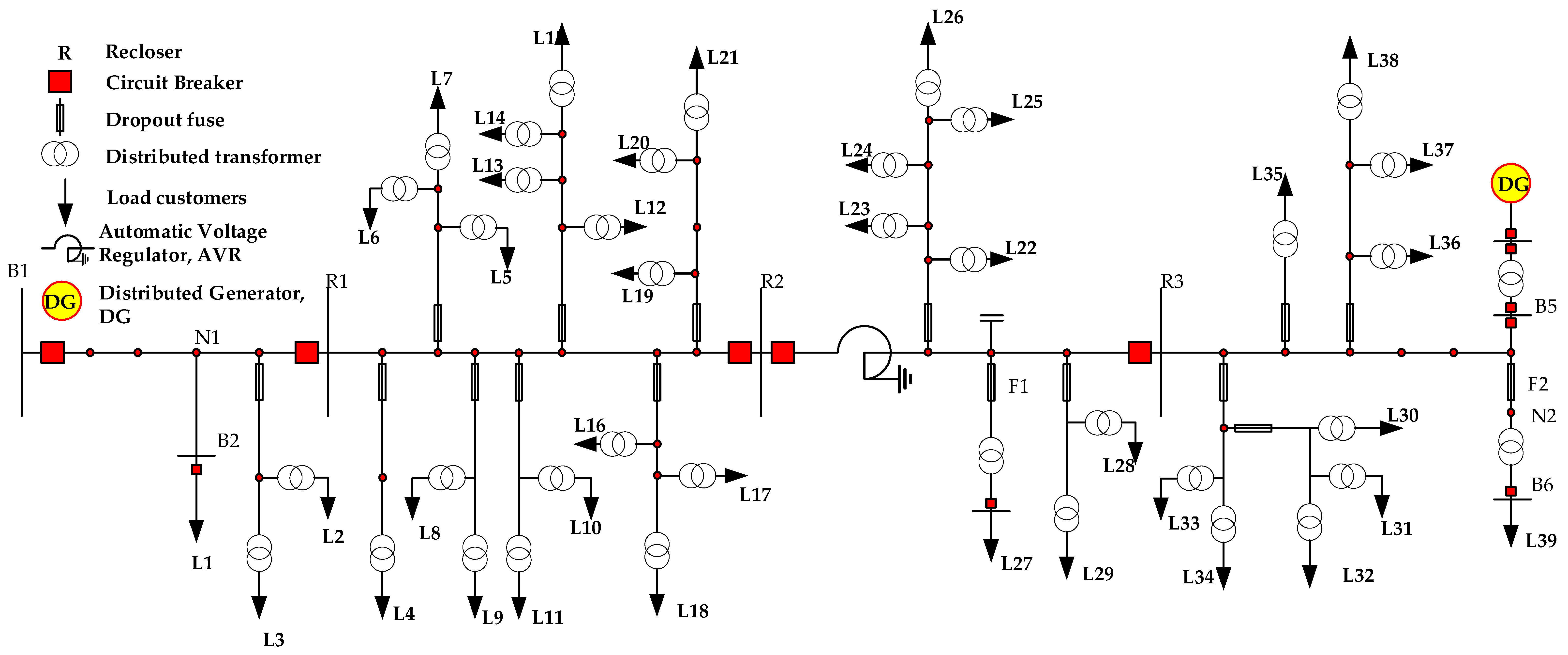
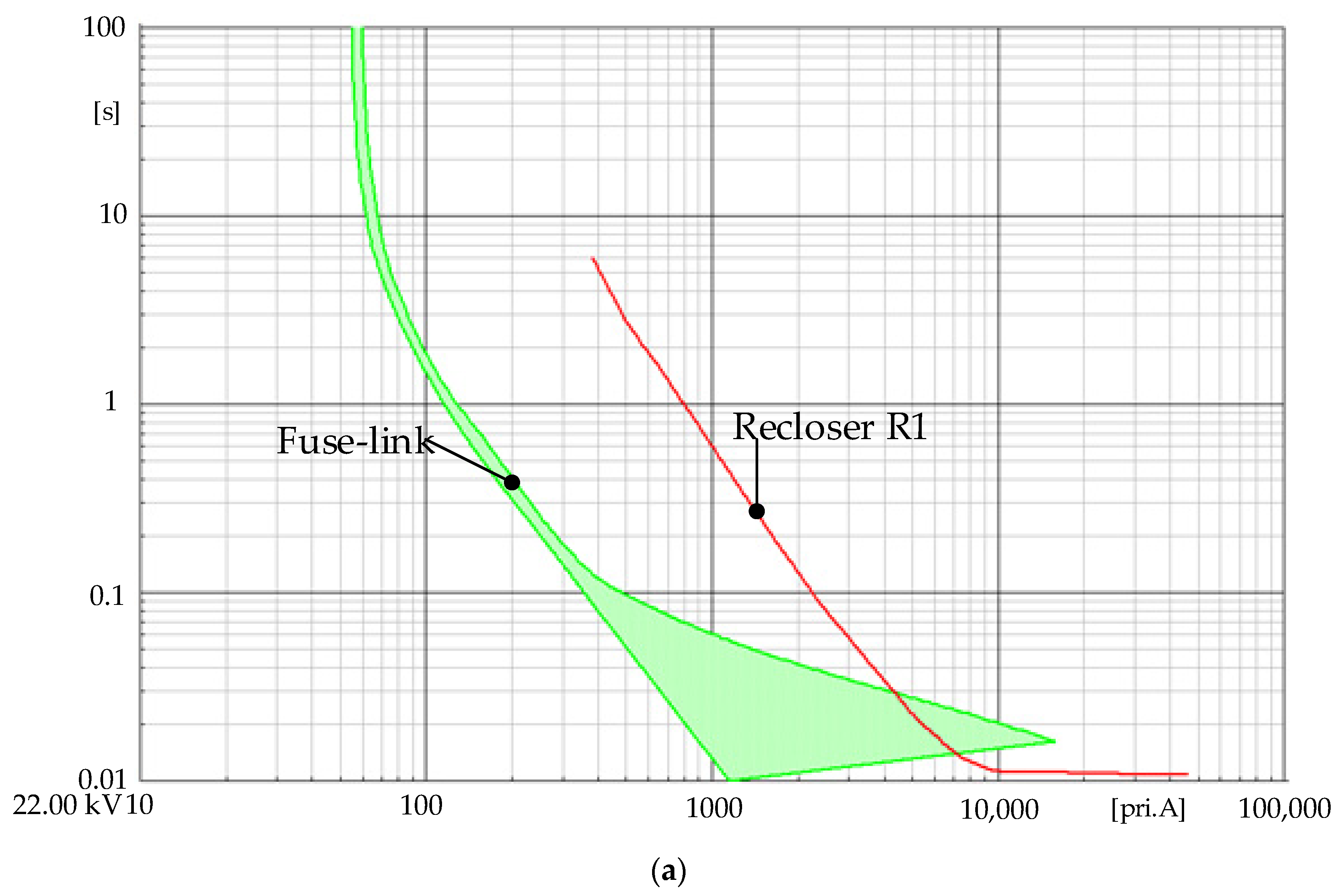


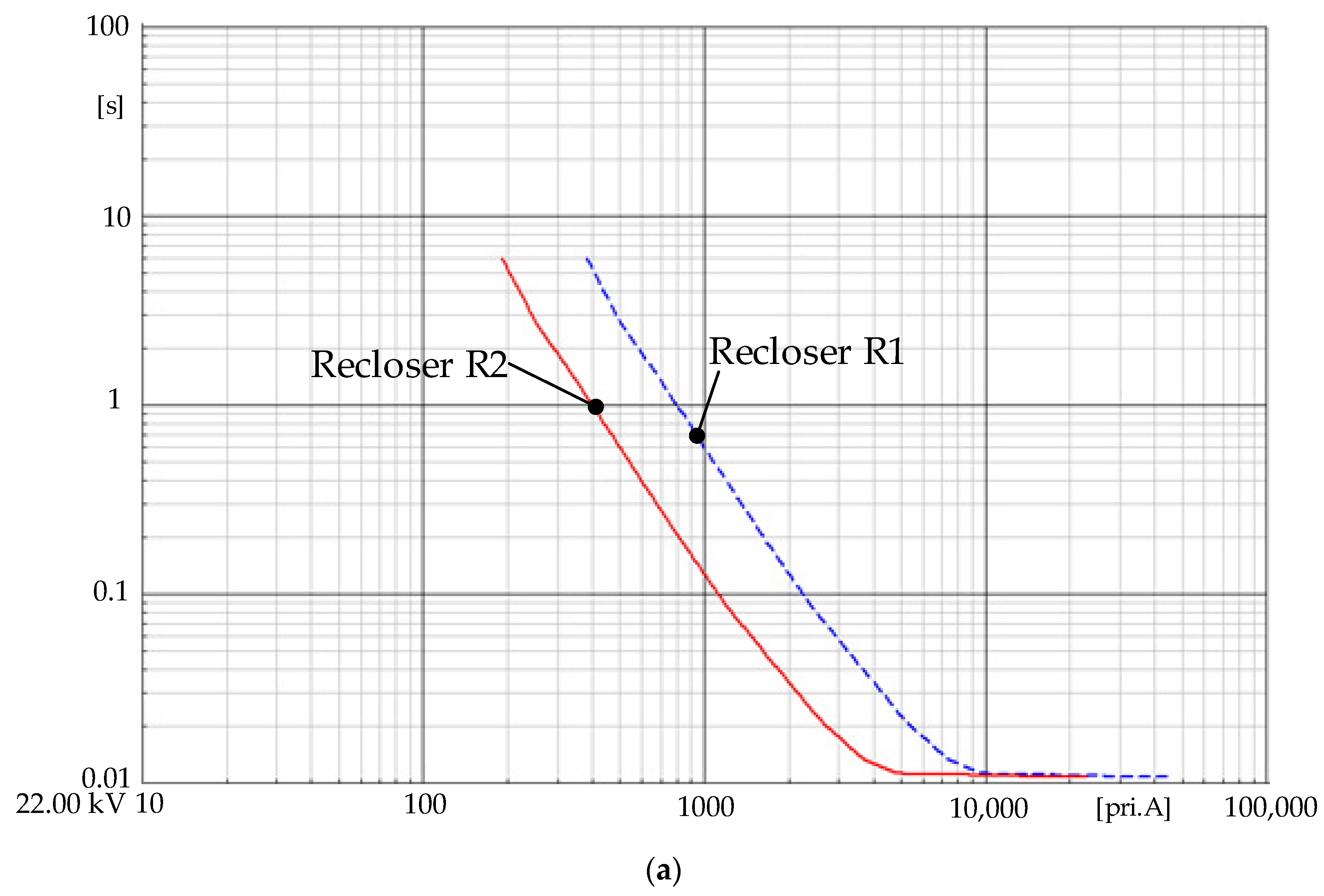

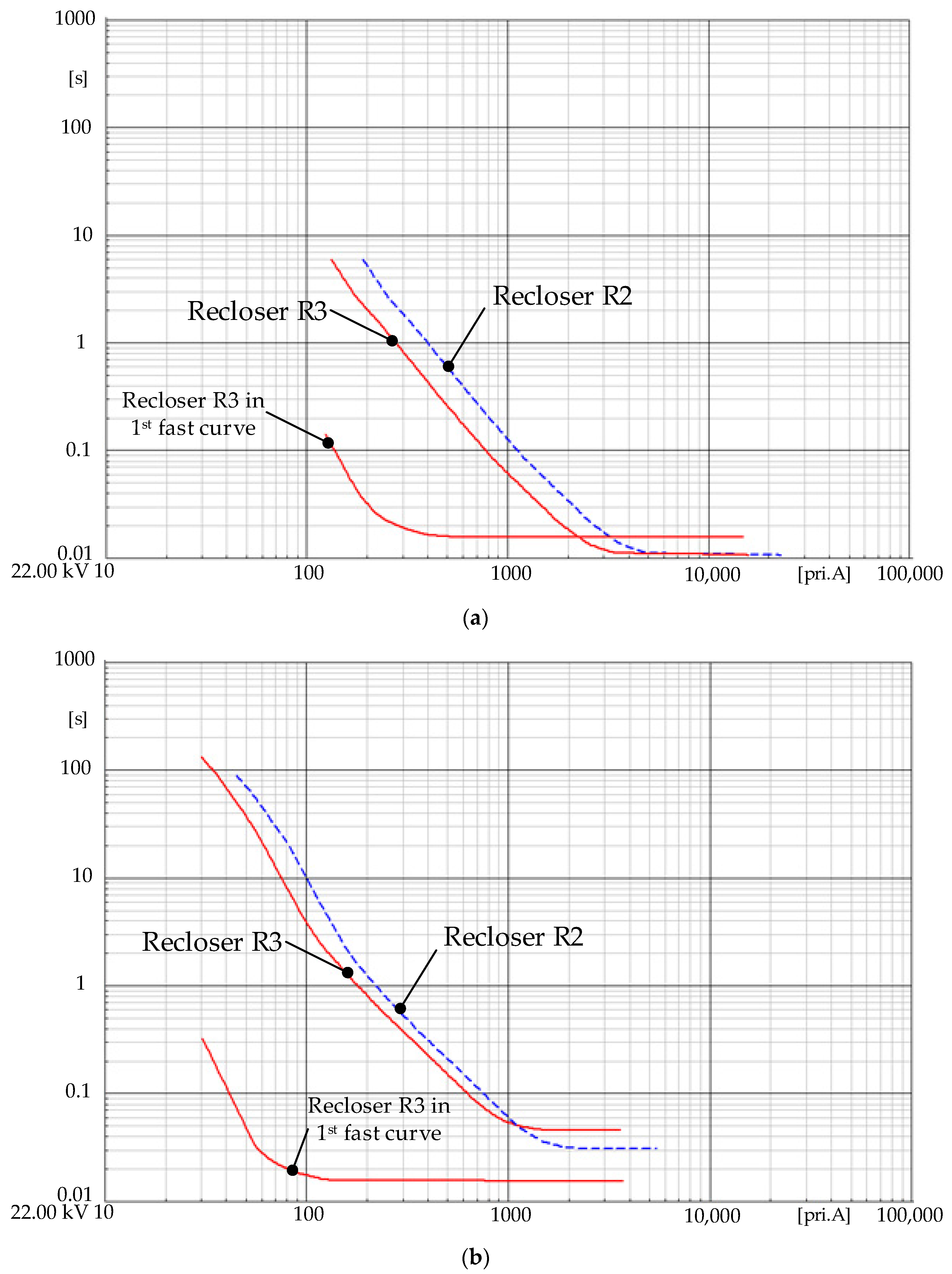
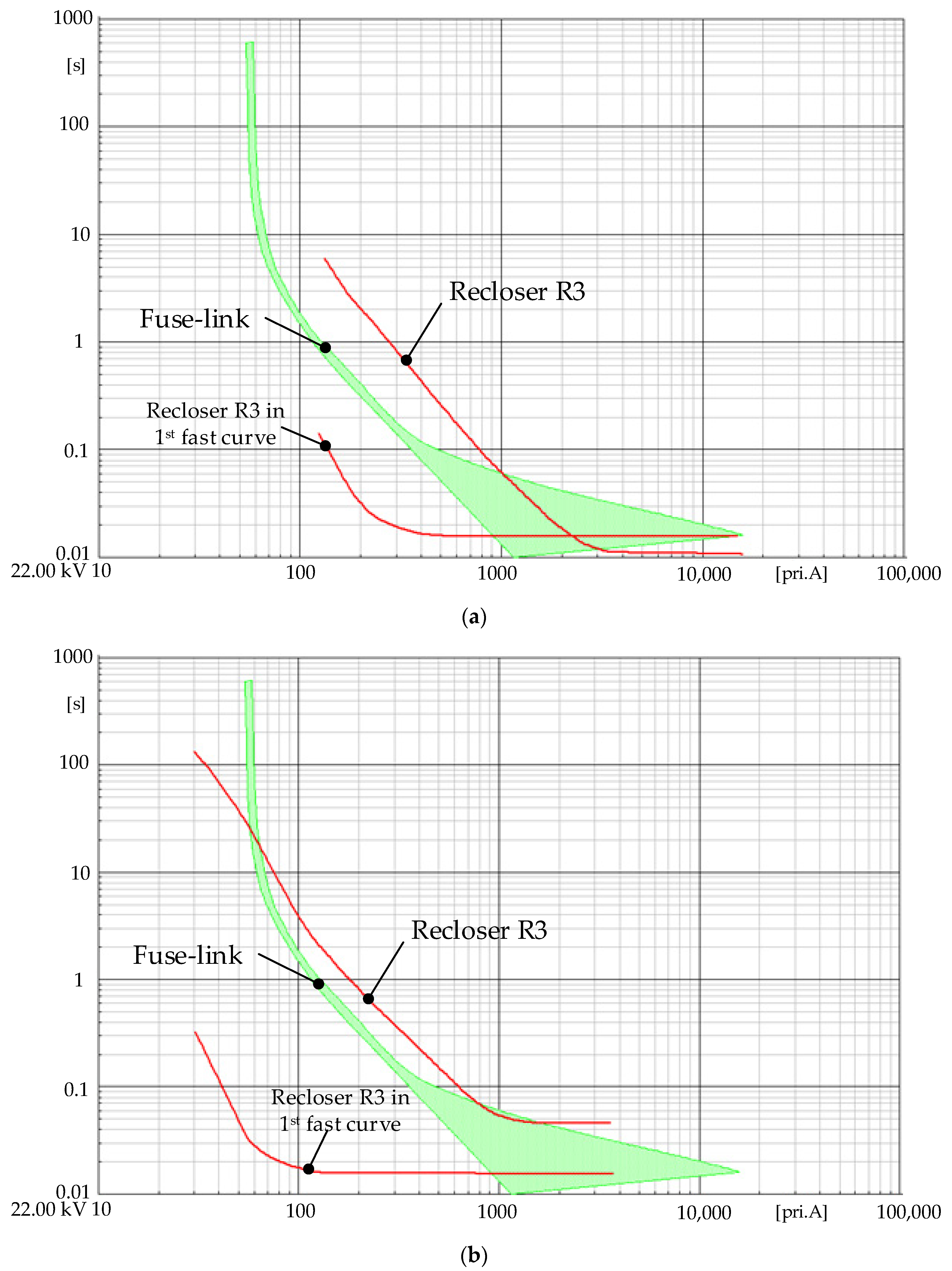
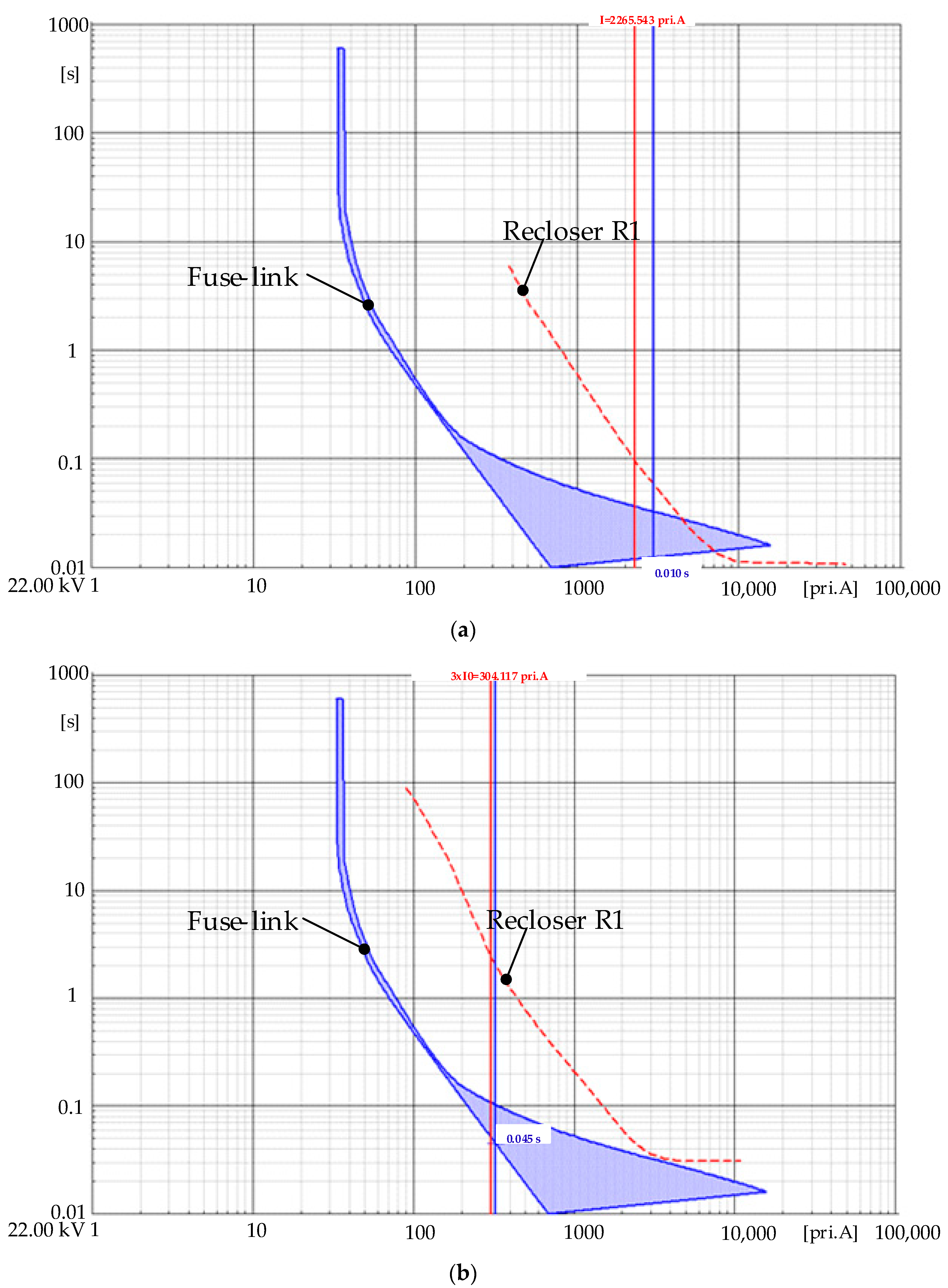
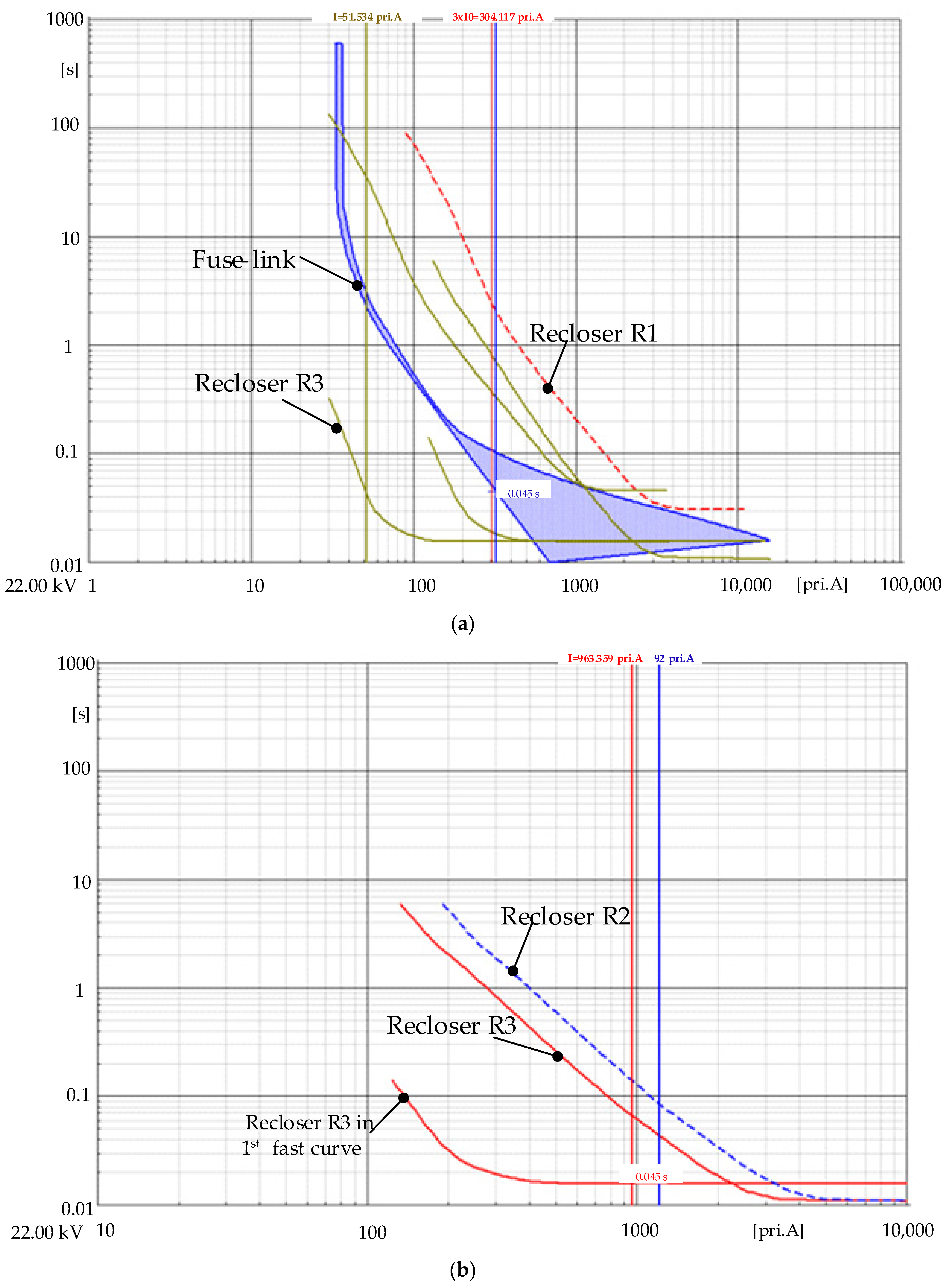
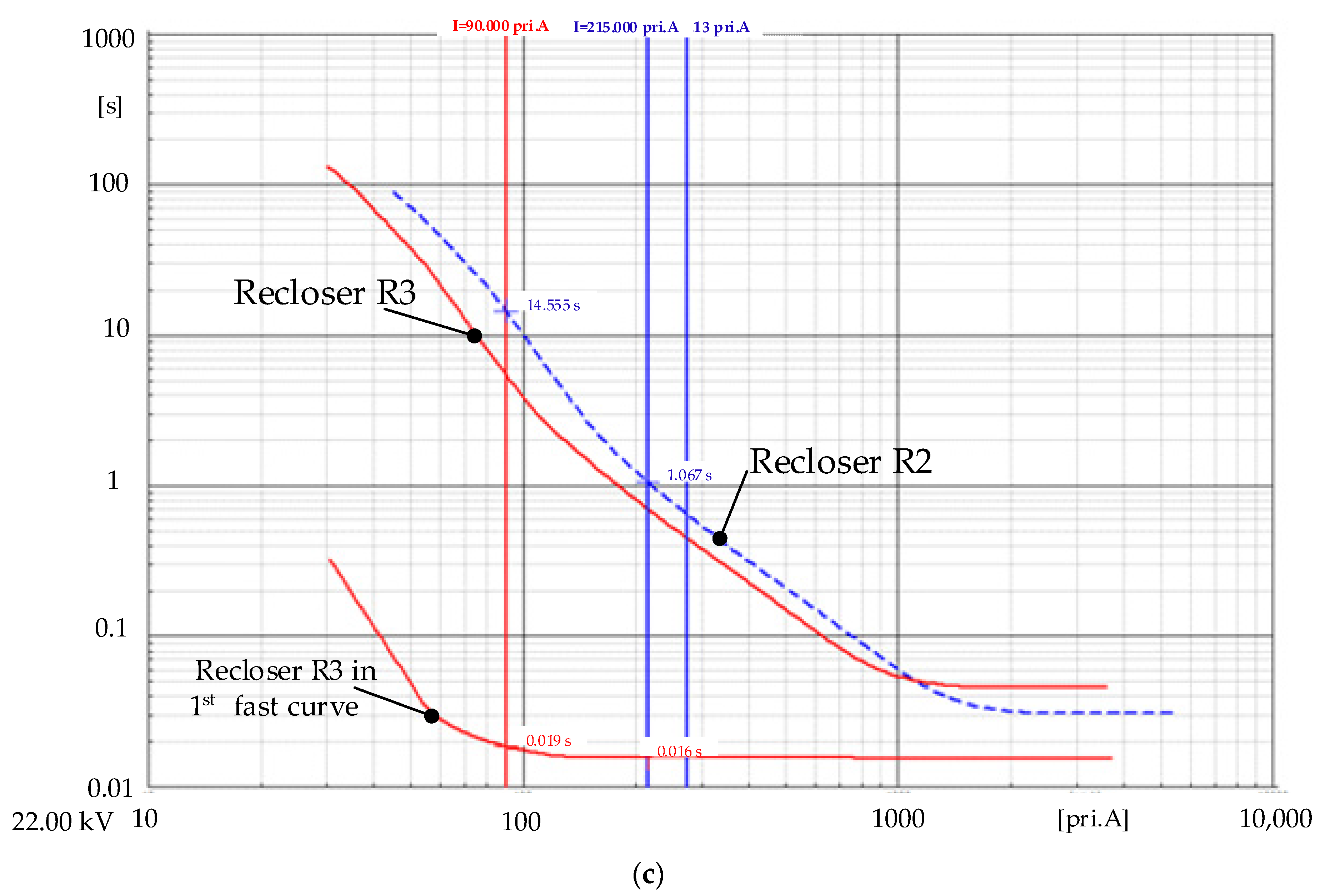
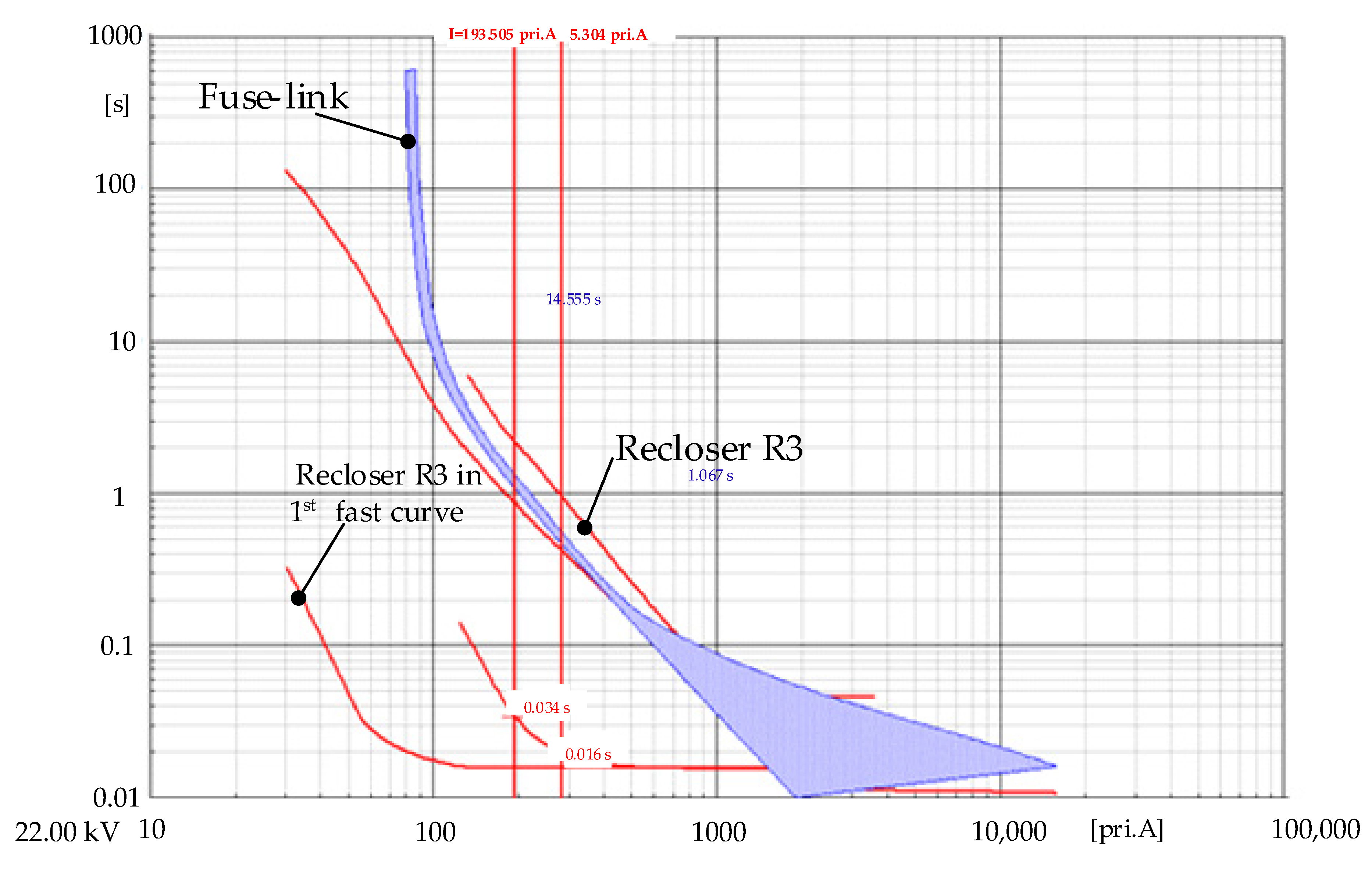
| Load Position | Load Types | Load Demand (kVA) |
|---|---|---|
| L1 | Medium scale industry | 2700 |
| L2, L12, L19 | Residential | 50 |
| L3, L4, L6, L9, L10, L13, L15, L32, L37 | Residential | 250 |
| L5, L16, L17, L18, L23, L25, L30, L34, L36, L38 | Residential | 150 |
| L7, L11, L27 | Small scale industry | 500 |
| L8, L14, L21, L22, L24, L26, L31, L33, L35 | Residential | 100 |
| L20 | Residential | 30 |
| L28 | Residential | 10 |
| L29 | Residential | 100 |
| L39 | Medium scale industry | 1000 |
| Descriptions | Technical Information | ||||
|---|---|---|---|---|---|
| Cross-Section Area | 50 mm2 | 50 mm2 | 50 mm2 | 185 mm2 | 185 mm2 |
| Cable type | SAC | PIC | ACSR | PIC | SAC |
| Lead conductor | 3 conductors | ||||
| Type of conductor | Aluminum | ||||
| Outer diameters | 8.00 mm. | 8.00 mm. | 8.00 mm. | 15.80 mm. | 15.98 mm. |
| DC resistance | 0.641 Ω | 0.5711 Ω | 0.5711 Ω | 0.164 Ω | 0.164 Ω |
| Cable Types | Zero Sequence | Positive Sequence | Negative Sequence | |||
|---|---|---|---|---|---|---|
| R0 | X0 | R1 | X1 | R2 | X2 | |
| 50SAC | 1.019329 | 1.897538 | 0.8219353 | 0.3395188 | 0.8219353 | 0.3395188 |
| 50PIC | 1.001667 | 1.670839 | 0.8219279 | 0.4553402 | 0.8219279 | 0.4553402 |
| 50ACSR | 0.8219702 | 1.669577 | 0.6403365 | 0.4545099 | 0.6403365 | 0.4545099 |
| 185PIC | 0.3913551 | 1.629687 | 0.2106576 | 0.4144061 | 0.2106576 | 0.4144061 |
| 185SAC | 0.402942 | 1.857875 | 0.2106598 | 0.2985855 | 0.2106598 | 0.2985855 |
| Distancing from Substation | Voltage Level by Individual Location (kV) | |||||||||||||
|---|---|---|---|---|---|---|---|---|---|---|---|---|---|---|
| Without DG | 2 km | 4 km | 6 km | 8 km | 10 km | 12 km | 14 km | 16 km | 18 km | 20 km | 22 km | 24 km | 26 km | |
| 2 km | 22.610 | 22.759 | 22.772 | 22.785 | 22.792 | 22.799 | 22.802 | 22.803 | 22.798 | 22.797 | 22.794 | 22.788 | 22.782 | 22.776 |
| 4 km | 22.358 | 22.509 | 22.668 | 22.686 | 22.696 | 22.704 | 22.708 | 22.709 | 22.703 | 22.701 | 22.697 | 22.690 | 22.681 | 22.673 |
| 6 km | 22.107 | 22.261 | 22.423 | 22.587 | 22.598 | 22.609 | 22.614 | 22.615 | 22.608 | 22.606 | 22.600 | 22.591 | 22.580 | 22.570 |
| 8 km | 22.909 | 22.065 | 22.229 | 22.395 | 22.552 | 22.564 | 22.570 | 22.572 | 22.563 | 22.560 | 22.553 | 22.543 | 22.530 | 22.517 |
| 10 km | 21.721 | 21.879 | 22.045 | 22.213 | 22.372 | 22.530 | 22.537 | 22.538 | 22.529 | 22.525 | 22.517 | 22.504 | 22.490 | 22.475 |
| 12 km | 21.589 | 21.748 | 21.916 | 22.086 | 22.246 | 22.405 | 22.557 | 22.558 | 22.547 | 22.543 | 22.534 | 22.519 | 22.503 | 22.486 |
| 14 km | 21.497 | 21.658 | 21.826 | 21.997 | 22.159 | 22.319 | 22.472 | 22.617 | 22.605 | 22.600 | 22.589 | 22.574 | 22.555 | 22.536 |
| 16 km | 21.317 | 21.481 | 21.654 | 21.829 | 21.994 | 22.158 | 22.315 | 22.463 | 22.569 | 22.563 | 22.548 | 22.525 | 22.498 | 22.471 |
| 18 km | 21.243 | 21.408 | 21.581 | 21.758 | 21.924 | 22.089 | 22.246 | 22.395 | 22.502 | 22.639 | 22.622 | 22.598 | 22.569 | 22.540 |
| 20 km | 21.167 | 21.332 | 21.507 | 21.684 | 21.851 | 22.016 | 22.174 | 22.324 | 22.431 | 22.568 | 22.694 | 22.688 | 22.637 | 22.606 |
| 22 km | 21.114 | 21.280 | 21.455 | 21.632 | 21.800 | 21.965 | 22.124 | 22.274 | 22.381 | 22.519 | 22.645 | 22.760 | 22.727 | 22.694 |
| 24 km | 21.079 | 21.246 | 21.421 | 21.599 | 21.766 | 21.932 | 22.091 | 22.241 | 22.349 | 22.487 | 22.613 | 22.729 | 22.826 | 22.802 |
| 26 km | 21.045 | 21.211 | 21.387 | 21.565 | 21.733 | 21.899 | 22.058 | 22.209 | 22.317 | 22.454 | 22.581 | 22.697 | 22.805 | 22.911 |
| Distance of DG Placement from Substation (km) | Power Loss (kW) |
|---|---|
| without DG | 370 |
| 2 | 350 |
| 4 | 280 |
| 6 | 210 |
| 8 | 180 |
| 10 | 150 |
| 12 | 140 |
| 14 | 150 |
| 16 | 160 |
| 18 | 170 |
| 20 | 190 |
| 22 | 230 |
| 24 | 270 |
| 26 | 300 |
| Locations | Maximum Current (A) | Minimum Current (A) | ||
|---|---|---|---|---|
| 3 Φ | 1 Φ | 3 Φ | 1 Φ | |
| 1 | 2812 | 326 | 2464 | 234 |
| 2 | 2464 | 218 | 2050 | 314 |
| 3 | 2266 | 313 | 1821 | 307 |
| 4 | 2190 | 311 | 1534 | 295 |
| 5 | 2178 | 311 | 1394 | 288 |
| 6 | 2085 | 308 | 1527 | 295 |
| 7 | 2021 | 306 | 1492 | 293 |
| 8 | 1970 | 304 | 1863 | 303 |
| 9 | 1921 | 302 | 1040 | 264 |
| 10 | 1290 | 296 | 968 | 266 |
| 11 | 1230 | 291 | 1045 | 274 |
| 12 | 1211 | 289 | 935 | 262 |
| 13 | 1141 | 282 | 627 | 219 |
| 14 | 1109 | 279 | 1012 | 269 |
| 15 | 1079 | 276 | 752 | 237 |
| 16 | 937 | 258 | 836 | 244 |
| Recloser Position | Phase Setting | Ground Setting |
|---|---|---|
| R1 | Pick up = 360 A Curve TCC 2 = 116 Time Interval = 10 s Reset Time = 120 s | Pick up = 90 A Curve TCC 2 = 165 Time Interval = 10 s Reset Time = 120 s |
| Recloser Position | Phase Setting | Ground Setting |
|---|---|---|
| R2 | Pick up = 180 A Curve TCC 2 = 116 Time Interval = 10 s Reset Time = 120 s | Pick up = 45 A Curve TCC 2 = 165 Time Interval = 10 s Reset Time = 120 s |
| Recloser Position | Phase Setting | Ground Setting |
|---|---|---|
| R3 | Pick up = 125 A Curve TCC 1 = 101 Curve TCC 2 = 116 Time Interval 1 = 5 s Time Interval 2 = 15 s Reset Time = 120 s | Pick up = 30 A Curve TCC 2 = 102 Curve TCC 2 = 165 Time dial 1.5 Time Interval 1 = 5 s Time Interval 2 = 15 s Reset Time = 120 s |
| Fault Locations | Maximum Current (A) | Minimum Current (A) | ||||
|---|---|---|---|---|---|---|
| At Fault Position | At Substation | At DG | At Fault Position | At Substation | At DG | |
| 1 | 3447 | 2812 | 666 | 2960 | 2394 | 567 |
| 2 | 3149 | 2464 | 688 | 2506 | 1960 | 548 |
| 3 | 2965 | 2266 | 705 | 2251 | 1720 | 535 |
| 4 | 2896 | 2190 | 712 | 1852 | 1400 | 455 |
| 5 | 2885 | 2178 | 713 | 1654 | 1248 | 409 |
| 6 | 2801 | 2085 | 723 | 1883 | 1402 | 486 |
| 7 | 2743 | 2021 | 731 | 1857 | 1368 | 495 |
| 8 | 2698 | 1970 | 737 | 2233 | 1630 | 610 |
| 9 | 2655 | 1921 | 744 | 1224 | 885 | 343 |
| 10 | 2207 | 1290 | 921 | 1404 | 821 | 586 |
| 11 | 2177 | 1230 | 952 | 1663 | 940 | 728 |
| 12 | 2168 | 1211 | 963 | 1420 | 794 | 631 |
| 13 | 2141 | 1141 | 1010 | 1279 | 841 | 397 |
| 14 | 2131 | 1109 | 1034 | 1821 | 943 | 880 |
| 15 | 2124 | 1079 | 1060 | 1152 | 585 | 575 |
| 16 | 2130 | 937 | 1224 | 1688 | 742 | 970 |
| Fault Locations | Maximum Current (A) | Minimum Current (A) | ||||
|---|---|---|---|---|---|---|
| At Fault Location | At Substation | At DG | At Fault Location | At Substation | At DG | |
| 1 | 333 | 286 | 47 | 326 | 280 | 46 |
| 2 | 328 | 274 | 54 | 318 | 265 | 52 |
| 3 | 326 | 267 | 59 | 291 | 255 | 56 |
| 4 | 325 | 264 | 61 | 279 | 244 | 56 |
| 5 | 324 | 263 | 61 | 273 | 238 | 55 |
| 6 | 323 | 259 | 64 | 278 | 241 | 59 |
| 7 | 322 | 256 | 66 | 275 | 239 | 61 |
| 8 | 322 | 253 | 67 | 284 | 245 | 65 |
| 9 | 320 | 251 | 69 | 247 | 213 | 58 |
| 10 | 310 | 224 | 86 | 278 | 201 | 77 |
| 11 | 307 | 217 | 89 | 288 | 204 | 84 |
| 12 | 305 | 215 | 90 | 276 | 195 | 82 |
| 13 | 301 | 207 | 95 | 231 | 159 | 73 |
| 14 | 298 | 202 | 97 | 287 | 195 | 93 |
| 15 | 296 | 198 | 99 | 254 | 170 | 84 |
| 16 | 285 | 177 | 109 | 268 | 167 | 103 |
| Distancing (km) | Voltage Level without DG (kV) | Voltage Level with DG (kV) |
|---|---|---|
| 2 | 22.62 | 22.85 |
| 4 | 22.36 | 22.69 |
| 6 | 22.10 | 22.58 |
| 8 | 21.89 | 22.52 |
| 10 | 21.80 | 22.20 |
| 12 | 22.44 | 22.20 |
| 14 | 22.32 | 22.25 |
| 16 | 22.23 | 22.31 |
| 18 | 22.15 | 22.42 |
| 20 | 22.08 | 22.43 |
| 22 | 22.01 | 22.52 |
| 24 | 21.96 | 22.63 |
| 26 | 21.90 | 22.73 |
Disclaimer/Publisher’s Note: The statements, opinions and data contained in all publications are solely those of the individual author(s) and contributor(s) and not of MDPI and/or the editor(s). MDPI and/or the editor(s) disclaim responsibility for any injury to people or property resulting from any ideas, methods, instructions or products referred to in the content. |
© 2023 by the authors. Licensee MDPI, Basel, Switzerland. This article is an open access article distributed under the terms and conditions of the Creative Commons Attribution (CC BY) license (https://creativecommons.org/licenses/by/4.0/).
Share and Cite
Ngamroo, I.; Kotesakha, W.; Yoomak, S.; Kunakorn, A. Impact on Protective Device Sequence of Operation in Case Distributed Generation Integrated to Distribution System. Appl. Sci. 2023, 13, 7970. https://doi.org/10.3390/app13137970
Ngamroo I, Kotesakha W, Yoomak S, Kunakorn A. Impact on Protective Device Sequence of Operation in Case Distributed Generation Integrated to Distribution System. Applied Sciences. 2023; 13(13):7970. https://doi.org/10.3390/app13137970
Chicago/Turabian StyleNgamroo, Issarachai, Wikorn Kotesakha, Suntiti Yoomak, and Anantawat Kunakorn. 2023. "Impact on Protective Device Sequence of Operation in Case Distributed Generation Integrated to Distribution System" Applied Sciences 13, no. 13: 7970. https://doi.org/10.3390/app13137970
APA StyleNgamroo, I., Kotesakha, W., Yoomak, S., & Kunakorn, A. (2023). Impact on Protective Device Sequence of Operation in Case Distributed Generation Integrated to Distribution System. Applied Sciences, 13(13), 7970. https://doi.org/10.3390/app13137970





